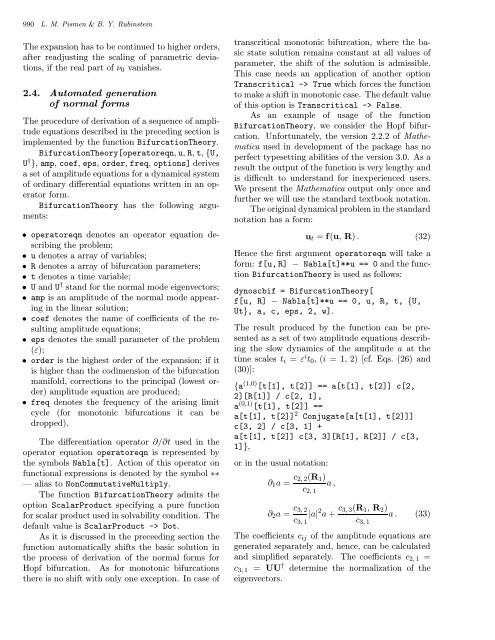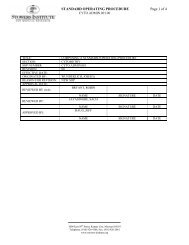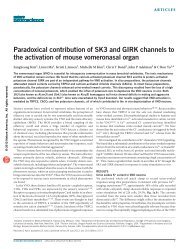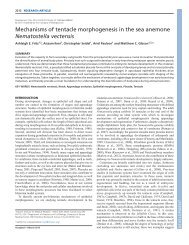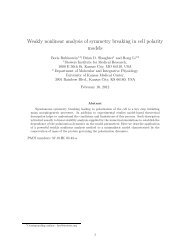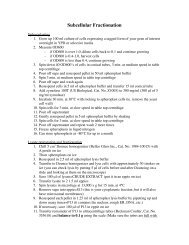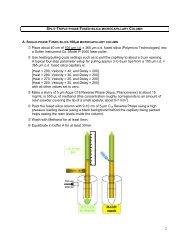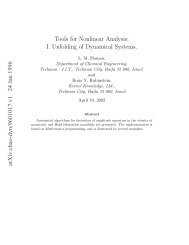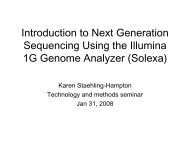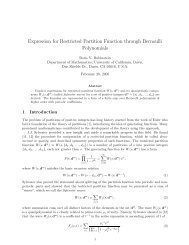Computer Tools for Bifurcation Analysis: General Approach with
Computer Tools for Bifurcation Analysis: General Approach with
Computer Tools for Bifurcation Analysis: General Approach with
You also want an ePaper? Increase the reach of your titles
YUMPU automatically turns print PDFs into web optimized ePapers that Google loves.
990 L. M. Pismen & B. Y. Rubinstein<br />
The expansion has to be continued to higher orders,<br />
after readjusting the scaling of parametric deviations,<br />
if the real part of ν 0 vanishes.<br />
2.4. Automated generation<br />
of normal <strong>for</strong>ms<br />
The procedure of derivation of a sequence of amplitude<br />
equations described in the preceding section is<br />
implemented by the function <strong>Bifurcation</strong>Theory.<br />
<strong>Bifurcation</strong>Theory[operatoreqn, u, R, t, {U,<br />
U † }, amp, coef, eps, order, freq, options] derives<br />
a set of amplitude equations <strong>for</strong> a dynamical system<br />
of ordinary differential equations written in an operator<br />
<strong>for</strong>m.<br />
<strong>Bifurcation</strong>Theory has the following arguments:<br />
• operatoreqn denotes an operator equation describing<br />
the problem;<br />
• u denotes a array of variables;<br />
• R denotes a array of bifurcation parameters;<br />
• t denotes a time variable;<br />
• U and U † stand <strong>for</strong> the normal mode eigenvectors;<br />
• amp is an amplitude of the normal mode appearing<br />
in the linear solution;<br />
• coef denotes the name of coefficients of the resulting<br />
amplitude equations;<br />
• eps denotes the small parameter of the problem<br />
(ε);<br />
• order is the highest order of the expansion; if it<br />
is higher than the codimension of the bifurcation<br />
manifold, corrections to the principal (lowest order)<br />
amplitude equation are produced;<br />
• freq denotes the frequency of the arising limit<br />
cycle (<strong>for</strong> monotonic bifurcations it can be<br />
dropped).<br />
The differentiation operator ∂/∂t used in the<br />
operator equation operatoreqn is represented by<br />
the symbols Nabla[t]. Action of this operator on<br />
functional expressions is denoted by the symbol ∗∗<br />
— alias to NonCommutativeMultiply.<br />
The function <strong>Bifurcation</strong>Theory admits the<br />
option ScalarProduct specifying a pure function<br />
<strong>for</strong> scalar product used in solvability condition. The<br />
default value is ScalarProduct -> Dot.<br />
As it is discussed in the preceeding section the<br />
function automatically shifts the basic solution in<br />
the process of derivation of the normal <strong>for</strong>ms <strong>for</strong><br />
Hopf bifurcation. As <strong>for</strong> monotonic bifurcations<br />
there is no shift <strong>with</strong> only one exception. In case of<br />
transcritical monotonic bifurcation, where the basic<br />
state solution remains constant at all values of<br />
parameter, the shift of the solution is admissible.<br />
This case needs an application of another option<br />
Transcritical -> True which <strong>for</strong>ces the function<br />
to make a shift in monotonic case. The default value<br />
of this option is Transcritical -> False.<br />
As an example of usage of the function<br />
<strong>Bifurcation</strong>Theory, we consider the Hopf bifurcation.<br />
Un<strong>for</strong>tunately, the version 2.2.2 of Mathematica<br />
used in development of the package has no<br />
perfect typesetting abilities of the version 3.0. As a<br />
result the output of the function is very lengthy and<br />
is difficult to understand <strong>for</strong> inexperienced users.<br />
We present the Mathematica output only once and<br />
further we will use the standard textbook notation.<br />
The original dynamical problem in the standard<br />
notation has a <strong>for</strong>m:<br />
u t = f(u, R) . (32)<br />
Hence the first argument operatoreqn will take a<br />
<strong>for</strong>m: f[u, R] − Nabla[t]**u == 0 and the function<br />
<strong>Bifurcation</strong>Theory is used as follows:<br />
dynoscbif = <strong>Bifurcation</strong>Theory[<br />
f[u, R] − Nabla[t]**u == 0, u, R, t, {U,<br />
Ut}, a, c, eps, 2, w].<br />
The result produced by the function can be presented<br />
as a set of two amplitude equations describing<br />
the slow dynamics of the amplitude a at the<br />
time scales t i = ε i t 0 , (i =1,2) [cf. Eqs. (26) and<br />
(30)]:<br />
{a (1,0) [t[1], t[2]] == a[t[1], t[2]] c[2,<br />
2][R[1]] / c[2, 1],<br />
a (0,1) [t[1], t[2]] ==<br />
a[t[1], t[2]] 2 Conjugate[a[t[1], t[2]]]<br />
c[3, 2] / c[3, 1] +<br />
a[t[1], t[2]] c[3, 3][R[1], R[2]] / c[3,<br />
1]},<br />
or in the usual notation:<br />
∂ 1 a = c 2, 2(R 1 )<br />
a,<br />
c 2, 1<br />
∂ 2 a= c 3,2<br />
c 3,1<br />
|a| 2 a+ c 3,3(R 1 , R 2 )<br />
c 3,1<br />
a. (33)<br />
The coefficients c ij of the amplitude equations are<br />
generated separately and, hence, can be calculated<br />
and simplified separately. The coefficients c 2, 1 =<br />
c 3, 1 = UU † determine the normalization of the<br />
eigenvectors.


